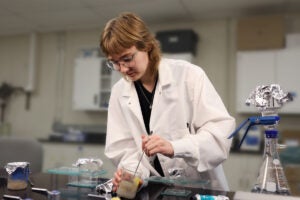Austin has a reputation for great outdoor spaces for hiking, canoeing, tossing Frisbees and more. Partly because of the Lady Bird Johnson Wildflower Center, the city known as a green energy leader is also making its mark as a place with innovative green landscapes that are as functional as they are beautiful.
In October, a massive mixed-use development called Mueller near the heart of downtown, began unveiling its park system developed with Wildflower Center help to include features such as a rare tallgrass prairie and demonstration gardens where visitors learn about using native plants in their own back yards.
Two members of the landscape restoration team at the Wildflower Center who consult on Mueller’s parks led public tours of the educational gardens, tallgrass prairie and other features of the innovative parks that are part of the 31-acre Southwest Greenway in mid-October.
The Wildflower Center was hired by RVi Planning + Landscape Architecture + Graphic Design, the lead park designer for Mueller and master developer Called Development Group, to work on the Southwest Greenway.
During the tours, the public walked through a row of desert willow trees shading park benches, learned how groupings of native plants add beauty to a site and how they help purify storm water and provide other environmental benefits (known as ecosystem services). They also viewed dozens of plants that grow well in Central Texas at the Demonstration Gardens to learn how to create a little bit of Texas on their own land. For Mueller residences, the information is especially useful since they are required to have at least 80 percent native plants in their yards.
The Demonstration Gardens showcase options for decorating areas near a creek, on a hillside or in other environments. Signage Wildflower Center staff developed in collaboration with RVi provides names of the native plants on display. Large clusters of the same plant, called monocultures, in the Demonstration Gardens show how a single species makes a dramatic visual impact.
“Just like the plants many people are used to putting in formal landscapes, native species can be laid out in clumps to show off their structure and beauty,” said Emily Manderson, an environmental designer at the Wildflower Center who led the first talk. Restoration ecologist Mark Simmons led a second talk.
Besides 14 species of Texas wildflowers, native plants that extend into the Southwest Greenway’s retention pond are within view, as are buffalo grass and several dozen other native grasses reclaiming blackland soils once buried beneath a parking lot at the former Robert Mueller Municipal Airport. Wildflower Center staff selected many of the plants and trees, which are adapted to Texas and require little watering or chemicals to maintain.
A special feature of the Greenway is a 3-acre tallgrass prairie, representing a landscape that used to stretch between Central Texas and Manitoba. About 99 percent of this tallgrass prairie has disappeared. The tallgrass was grown from seeds, but joining these grasses soon will be progeny from a small patch of Little bluestem that Simmons and colleagues discovered on site when the airport parking lot was torn out.
“That’s such a great find,” Simmons said, “because normally urban soil is so compacted and damaged that it’s pretty valueless ecologically.”
These genetic ancestors will become part of the tallgrass prairie near the Demonstration Gardens. Stretches of mixed grass prairie also occur nearby, and short grass prairie is being installed on the Greenway’s southern tip near Berkman Drive. Besides the glimpse these savannas provide into Texas’ past, they eliminate the environmental problems associated with parking lots, such as dumping chemically polluted storm water onto nearby land, and reflecting heat off of their paved surfaces.
Manderson and her colleagues at the Wildflower Center have also considered ecological benefits native landscapes provide while helping design other landscape features at Mueller, such as the pending Southeast Greenway. This input is part of their consulting work to assist commercial developers, national parks and others in understanding how to make sustainable landscapes that give people and wildlife nurturing settings to call home.
“Cities are where people live, and increasingly, we use our expertise in native plants and landscape restoration to create urban landscapes that give back to the environment,” said Manderson. “This project and others we have worked on, like the San Antonio River Mission Reach, the Advanced Micro Devices corporate campus and the reduced maintenance wildflower meadows at the Johnson Space Center provide models for sustainable landscapes.”



